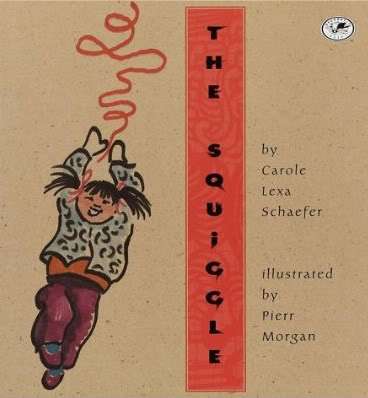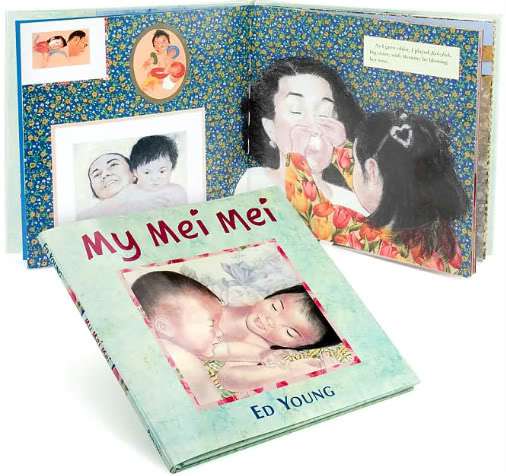
It’s been quite a month — flowers, salad, strawberries, and Asian Pacific American Heritage. As far as I’m concerned, every month is a time for ethnic pride, learning more about other cultures, and getting excited over books that feature new voices and perspectives. Do you need an excuse to eat more dim sum? Not me!
One of the ways I’ve been celebrating APAHM is to pick up some of the picture books I’d heard about, but never got around to reading. It was good to see titles featuring more Korean, Japanese, and South Asian characters, alongside the plentiful store of Chinese books. We still need more stories about Hawai’i and the Philippines, though, so I’d better get busy.
Anyway, today I’m serving up this tasty stir fry combining the flavors of Korea and China. Each title brims with its own brand of color, texture, and emotional resonance:
THE SQUIGGLE by Carole Lexa Schaefer, pictures by Pierr Morgan (Crown Publishers, 1996). A spirited little Chinese girl finds a red piece of string on the ground and exuberantly imagines what this newfound squiggle could be — a dragon? a great wall? the circle of a deep still pool? When she shares her perceptions with her classmates, of course they “get” it right away and let out a big cheer. The marker and gouache illos on oatmeal speckle tone paper are fresh and simple, pulling the reader right into the fun. I love the “slither slish, push-a-pat, crack crickle hiss” of the narrative! A real charmer.

NEW CLOTHES FOR NEW YEAR’S DAY by Hyun-Joo Bae (Kane/Miller, 2007). Translated from the original Korean, this sweet first person narrative follows a little girl who’s celebrating the Lunar New Year by putting on new clothes her mother has made for her. There is joy in each piece, from the crimson silk skirt, to the rainbow-striped jacket, delicate socks embroidered with flowers, to the hair ribbon of red and gold.
Hyun-Joo Bae’s winsome illos showing the girl’s expressions as she wraps the skirt around herself, tumbles over while putting on her socks, and struggles with her hair ribbon, are wonderfully captivating and provide an emotional focal point for the largely formal, precisely composed settings. An Author’s Note describes the significance of new clothes for New Year’s Day, and there’s a lovely diagram of the costume with proper Korean names for all the pieces.


WAITING FOR MAMA by Lee Tae-Jun, pictures by Kim Dong-Seong (North South Books, 2004). This haunting, poignant little tale, set in 1930’s Korea, features a small boy waiting at a streetcar station for his mother to arrive. It’s winter, and the boy seemingly waits a long time, in the cold and snow, as conductors on arriving streetcars answer his question about the whereabouts of his mother with a matter-of-fact, “Do I know your Mama?” The pastel and pencil illustrations, rendered in subdued ivories, browns and olives, enlarge the story, which is told in Korean Hangeul alongside its English translation. The boy is a paragon of patience, so tiny on the platform amongst other travelers, so alone in a big world. The final double page, wordless spread shows the boy and his mother walking home hand in hand in the midst of a blizzard. The story seems simple, but it’s capable of stirring deeper emotions, primarily because of the illustrations (the story was originally published in a newspaper in 1938).

MY MEI MEI by Ed Young (Philomel, 2006). This is the true story of how Ed Young and his family went to China to adopt a little sister, or “mei mei” for his daughter Antonia, and how she learned to be a big sister to little Ananda. Told from Antonia’s point of view, it traces the significant moments of this sibling relationship — starting from when Antonia first asks for a little sister, to them flying the “friendly sky” to China, to seeing Ananda for the first time, to experiencing jealousy and realizing “she was not all she ought to be” (requiring special teachers to learn to walk and talk). There is love and warmth in the simple yet significant ways the sisters eventually bond, and the gorgeous gouache, pastel and collage illustrations render the experience with such luminosity it takes the breath away. That I can feel a father’s love in every aspect of the story’s execution only deepens my veneration for it.

RUBY’S WISH by Shirin Yim Bridges, pictures by Sophie Blackall (Chronicle Books, 2002). A simply told, inspiring story based on the author’s grandmother’s experience of growing up in turn-of-the-century China at a time when females were married off rather than educated. Ruby (named for her love of the color red), displays an independent spirit and love for learning, even while respecting what tradition dictates. Young readers will likely admire Ruby’s quiet determination as she continues with her studies while fulfilling domestic obligations. Thanks to a special relationship with her wise and enlightened grandfather, Ruby eventually realizes her wish of attending university. Sophie Blackall’s gouache illos effectively depict Sophie’s unconventional personality and contain just the right kind of details to keep readers engaged all the way through.

MY NAME IS YOON by Helen Recorvits, pictures by Gabi Swiatkowska (FSG, 2003). The satisfying story of how a Korean girl, Yoon, learns to adjust to her new life in America. Feeling alone and alienated from her classmates, Yoon resists writing her name, which means “Shining Wisdom,” in English. She much prefers to write her name in Korean, where the “symbols dance together,” saying that in English, all the lines and circles stand alone. Each day as the teacher encourages her to write “Yoon” in English, Yoon chooses instead to write a word that reflects her inner feelings — a CAT, which could hide in a corner, or a BIRD, which could fly back to Korea.
One day, a classmate gives Yoon a cupcake, and she expresses her happiness by writing CUPCAKE. Growing feelings of acceptance coupled with the teacher’s smiles, finally prompt Yoon to write her name in English, as she realizes she will still be Yoon in any language. Swiatkowska’s paintings dramatically depict Yoon’s transition from alienation to acceptance, as they go from starkly spare and surreal to warm and humanizing.

UNCLE PETER’S AMAZING CHINESE WEDDING by Lenore Look, pictures by Yumi Heo (Atheneum, 2006). Feisty, spirited Jenny feels like “an umbrella turned inside out” at the prospect of her Uncle Peter’s upcoming nuptials. After all, she’s always been his best girl, and now, Stella, an interloper in a red dress who’s the new center of Peter’s universe, threatens her every happiness. Several fascinating Chinese wedding traditions, including bargaining for the bride, bed jumping, and exchanging good luck money, are described in Jenny’s forthright, humorous voice. The lively telling is tempered by Jenny’s very believable sadness at losing her uncle, and Yumi Heo’s quirky, Maira Kalmanesque pencil, oil and collage illos perfectly depict this noisy, hectic family celebration with its jumble of emotions. Jenny will win you over from the start.
HAPPY READING!

These look like fantastic books!
and re: We still need more stories about Hawai’i and the Philippines, though…
you said it. We’re waiting on you.
LikeLike
thanks so much for these book recs- they all sound great!
LikeLike
Blow some good luck fairy dust my way! I’ve been dancing with a PB biography about a Hawaiian woman, but reaction has been that interest/potential audience isn’t wide enough, and the regional publishers are strapped these days, so . . .
LikeLike
These were the ones that stood out from the pile this go-around. My Mei Mei blew me away — but it’s Ed Young, so, I should have expected it.
LikeLike
Waaahhh! I want ALL of these books!!! Thanks for bringing them to our attention, Jama. 😀 Which one is your favorite of the bunch???
Tarie
Into the Wardrobe
LikeLike
All are definitely worth looking into, but I would have to say My Mei Mei and Uncle Peter’s Amazing Chinese Wedding are my faves of this bunch. Lenore Look’s Jenny is a joy to read — what a great voice! Ed Young’s work is just so sublime . . .
LikeLike
Thanks for the great suggestions — much needed!!
LikeLike
You’re very welcome, Mary Lee. Of course all of these titles taste better with some dim sum or kimchee :).
LikeLike
Elaine M.
These are some great picture books that you’ve highlighted in this post!
LikeLike
I enjoyed all of them very much :).
LikeLike